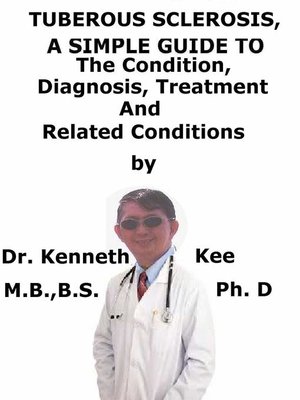Tuberous Sclerosis, a Simple Guide to the Condition, Diagnosis, Treatment and Related Conditions
ebook
By Kenneth Kee

Sign up to save your library
With an OverDrive account, you can save your favorite libraries for at-a-glance information about availability. Find out more about OverDrive accounts.
Find this title in Libby, the library reading app by OverDrive.



Search for a digital library with this title
Title found at these libraries:
| Library Name | Distance |
|---|---|
| Loading... |
This book describes Tuberous Sclerosis, Diagnosis and Treatment and Related Diseases
Tuberous sclerosis complex (TSC) is a genetic disorder that is typically featured by hamartomas in many organs, but especially the skin, brain, eye, kidney and heart.
Hamartomas are non-cancerous malformations comprising an overgrowth of the cells and tissues that normally happen in the affected area and include nevi (birthmarks).
It is inherited in an autosomal dominant manner and is characterized by a higher predisposition to hamartoma formation.
It happens from mutations in the genes TSC1 and TSC2 and is known for causing neurological disorders such as epilepsy and intellectual disability.
TSC is normally diagnosed in childhood or infancy, and the involved individuals may manifest with developmental delay, skin manifestations, or seizures.
Some presentations may be evident pre-natally, such as cardiac rhabdomyomas or cortical tubers.
Other signs, such as osseous, renal or pulmonary lesions are often diagnosed in adulthood.
The manifestation of the disease will differ depending on the developmental stage of the patient.
While skin lesions are identified in 90% of patients of all ages, hypo-pigmented macules are normally present in early childhood.
Causes
Tuberous sclerosis is a genetic disorder from a mutation in one of 2 genes:
1. TSC1, which produces a protein called hamartin (10–30% of cases)
2. TSC2, which produces a protein called tuberin
About one-third of all cases of tuberous sclerosis are inherited from an affected parent.
All other cases are due to sporadic new mutations happening in the early stages of life, most often mutations of TSC2.
Symptoms
A. Skin lesions are present in 60-70% of cases of tuberous sclerosis.
Angiofibromas
Ungual fibromas
Shagreen patch
Ovoid or ash leaf-shaped white macules
B. Other organ involvement
Epilepsy is evident in about 70% of patients with tuberous sclerosis.
It normally starts in infancy or early childhood before the appearance of skin lesions by years
Developmental delay and behavioral problems may also happen.
1. Mild to severe mental retardation,
2. Autism,
3. Attention deficit disorder (ADD),
4. Anxiety,
5. Depression,
6. Paranoia and
7. Schizophrenia.
Other signs and symptoms of tuberous sclerosis are:
1. Eye involvement: white spots on the iris and white lumps on the retina
2. Heart, gastrointestinal and kidney tumors
3. Lung changes
Diagnosis
Tuberous sclerosis is mainly diagnosed based on medical criteria but it can also be diagnosed with genetic testing.
Genetic testing of TSC1 and TSC2 is positive in 75% to 95% of patients affected with TSC
The diagnostic criteria for tuberous sclerosis involve these major and minor features:
Major Features
1. Hypo-melanotic macules (more than 2, and at least 5-mm in diameter)
2. Angiofibromas (more than 2) or fibrous cephalic plaque
3. Ungual fibromas (more than 1)
4. Shagreen patch
5. Multiple retinal hamartomas
6. Cortical dysplasias
7. Sub-ependymal nodules
8. Sub-ependymal giant cell astrocytoma
9. Cardiac rhabdomyoma
10. Lymphangioleiomyomatosis
11. Angiomyolipomas (more than 1)
Minor Features
1. Confetti skin lesions
2. Dental enamel Pitts (more than 3)
3. Intra-oral fibromas (more than 1)
4. Retinal achromic patch
5. Multiple renal cysts
6. Non-renal hamartomas
Treatment
Tuberous sclerosis is a multi-system disorder, so treatment from a team of doctors is necessary.
Laser treatment...







